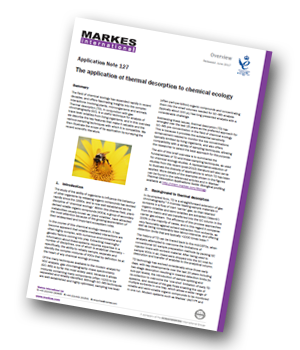Markes International has produced an application note that provides an overview of the fundamentals of thermal desorption (TD) and compatible sampling techniques, as used for chemical ecology studies.
 Introduction
Introduction
The study of the ability of organisms to influence the behaviour of other organisms by releasing organic compounds has evolved rapidly since the 1990s, and is now well-established as the discipline of ‘chemical ecology’ offering fascinating insights into the complex interactions involving plants, microorganisms and animals. Within this diverse field, plant-derived volatile organic compounds (VOCs), a group of secondary metabolites usually known as ‘plant volatiles’, have attracted the most attention because of the growing appreciation of their widespread and important ecosystem roles.
Why Use Thermal Desorption in Chemical Ecology?
Although GC–MS techniques are well-established and highly optimised, sampling low-level (often part-per-billion) organic compounds and concentrating them into the small volumes needed for GC–MS analysis (typically about 100 μL) has long presented analysts with a considerable challenge.
Addressing these issues, TD has emerged over the last 15 years as the preferred approach for GC–MS pre-concentration in the field of chemical ecology. This is because it provides the substantial sensitivity enhancement needed to monitor the low concentrations typically emitted by living organisms, and also offers compatibility with a variety of sampling techniques, allowing the researcher to select the best approach for the purpose.
Conclusions
TD is now applied to a wide (and expanding) range of chemical ecology applications. There is little doubt that future studies in chemical ecology will continue to rely upon the insights provided by analytical chemistry in general, and by TD–GC techniques in particular. In this overview, TD, in conjunction with GC, is shown to be a useful technique for analysis of trace-level volatiles from living organisms.




